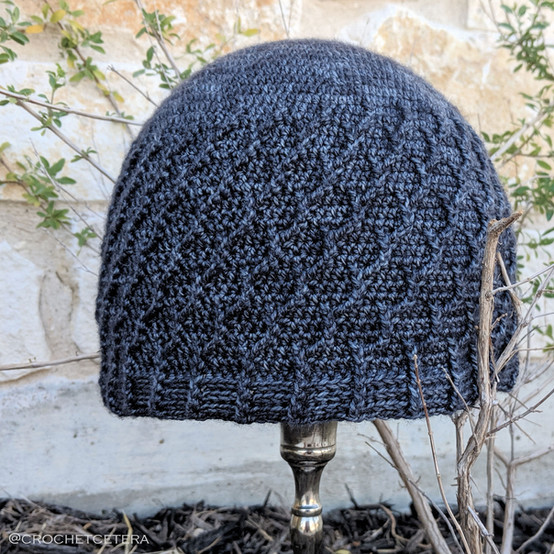Custom Hat Sizing
- Connie Lee Lynch
- Nov 22, 2022
- 4 min read
Let's talk about hats. I've made a fair few hats. Knit. Crochet. Top down. Bottom up. I definitely have my druthers! My personal preference is top (crown) down, but the biggest problem with doing hats in that way is getting it to be the right size, right? Have you ever gotten frustrated because you followed the instructions and thought you matched gauge - but the hat still turned out to be too small or too big? Yeah, me, too. It's disappointing, right? Well, I have a trick for you! And if you've worked from one of my hat patterns before, you've probably heard me talk about doing this already - unless it was the Brixel Hat, which convinced me I'd never design another bottom up hat again!
What I'm talking about is using the flat circle diameter to estimate the finished circumference of your hat. Here's the formula: Flat Circle Diameter x 3.14 = Circumference Have you done this before? What you do is you crochet in the round, creating a flat circle until it reaches a certain size, say 4" (10 cm) across. This measurement is your flat circle diameter. Like so:

With this measurement, we can now multiply it times pi, which is 3.14. So 4" (flat circle diameter) x 3.14 (pi) = 12.56" (circumference) or 10 cm x 3.14 = 31.4 cm for my metric makers. Most of us like to have a hat that fits with 1-2" (2.5-5 cm) of negative ease, which means that the circumference of the hat is actually smaller than our head circumference. This gives us a nice snug fit. So that means our hat that measures 12.5" (31 cm) will fit between a 12.5" (31 cm) and a 14.5" (36.5 cm) head circumference. Which is a baby hat. Now. Let's work this formula backwards. Say you have a perfectly average sized head circumference of 22" (56 cm). What is the flat circle diameter that you would want to work to? Time for some algebra! (And you thought you'd never use it again, right!?) If you want your hat to fit with 2" (5 cm) of negative ease, then your target circumference is 20" (51 cm). Here's our formula: X (flat circle diameter) x 3.14 (pi) = 20" (51 cm) circumference To determine X (flat circle diameter) you simply need to divide the target circumference by pi: 20" (51 cm) / 3.14 = 6.4" (16 cm) So that means you want to work until your flat circle measures approximately 6.4" (16 cm) straight across.

What happens if you're in between sizes, though? This is much more likely to occur with a heavier weight yarn or taller stitches, like you'll see in the Butternut Slub Hat. (Releasing next week!) So with this example pictured above, my third hat size has a flat circle diameter of 6.75" (17 cm) which would give me an estimated circumference of over 21" (53 cm). That means it should fit a 23" (58.5 cm) head - which is larger than the "average" head size of 22" (56 cm). My second hat size option has a flat circle diameter that is a tad less than 5.5" (14 cm), which only gives me an estimated circumference of 17" (43 cm), so it should fit a 19" (48 cm) head. That's an annoyingly large gap between sizes, right!? This is where knowing your preferred fit (how much negative ease/how snugly you like your hats to fit) as well as knowing your yarn comes in. For example, I knew this yarn would relax with blocking after making the cowl. Yes, I'm suggesting you block a swatch here if you aren't sure how your yarn will behave! I also know that I like a snug hat. And so I chose the smaller size option with the intention of aggressively blocking the finished hat. This is Estelle. She blocks my hats beautifully, doesn't she!?
Unfortunately for me, she has a slightly larger head than I do, so after blocking my previously too small hat, it actually turned out to be a tad looser than I wanted! How's that for the magic of blocking? Are you still with me? I know that was a lot of math! It's a great tool, though, that gives you greater control over the finished size of your hat, whether or not the pattern you're working from includes that information or not. So many hat patterns come in a "one size fits most" option, which really annoys me. And if it annoys me, then I know it annoys some of you, too! Have you used this method before? If not, I hope you're excited to try it the next time you make a hat! Speaking of which, here's are some of my currently available hat patterns:
Here are quicklinks for each of them if you already know which one you want!
Bifurcation Beanie: available on Ravelry
Brixel Hat: available on Ravelry
Bonus: my Baby C Hat is only written for one size (baby) but it's available for free here on my website AND now you know how to resize it for your own head if you want to!
Which one is going at the top of your queue!?











